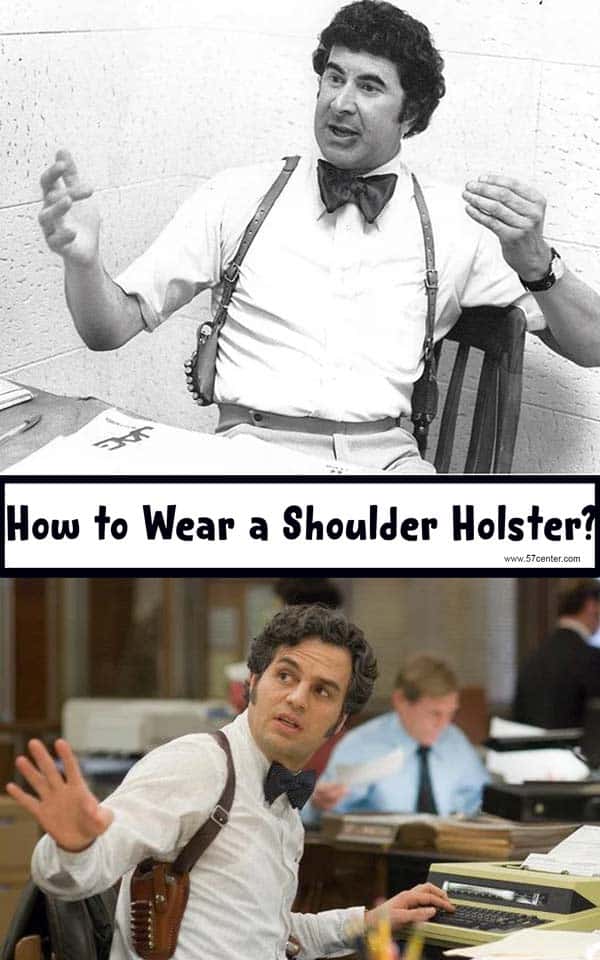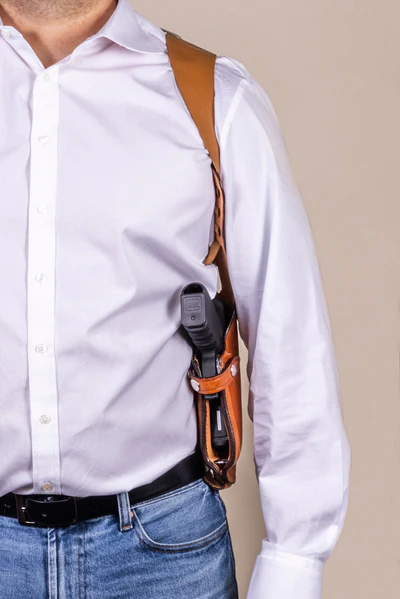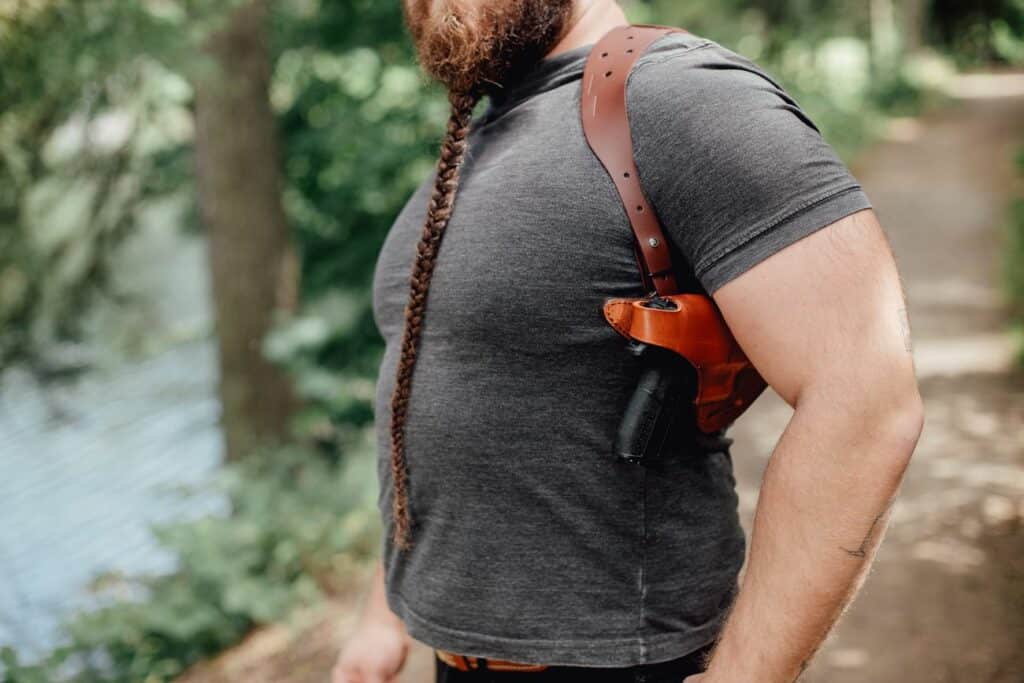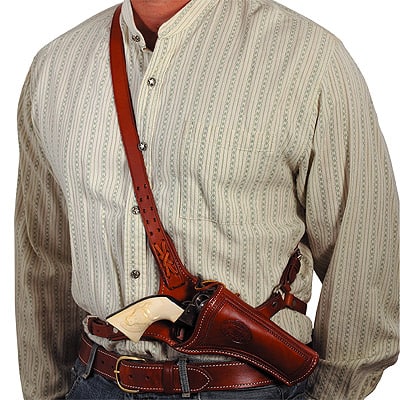Do you not know how to wear a shoulder holster?

… Then you probably haven’t seen James “Sonny” Crochet in the Miami Vice movie.
Shoulder holsters are not just attractive, as seen in the Miami classic, but they assure safety and other exciting benefits.
A shoulder holster, when worn adequately, can enhance the easy and free carriage of a weapon while running.
Even when driving or sitting, it is comfortable for individuals to draw out their guns from the holster quickly.
This article contains a step-by-step guide on how to wear a shoulder holster. It also features other essential information to be conscious of.
It wouldn’t take much of your time, and you should be wearing a shoulder holster with relative ease afterward.
Contents
- Introduction
- Types of Shoulder Holsters
- Getting Ready
- The functions of a shoulder holster
- Tips for Proper Maintenance and Care of a Shoulder Holster
- Cleaning and Lubricating the Holster
- A. Disassembling the Holster
- B. Gentle Handwashing
- C. Drying and Lubricating
- Regular Inspection for Wear and Tear
- A. Check the Stitching
- B. Examine the Straps and Buckles
- C. Assess the Retention System
- Storing the Holster Properly
- A. Store in a Cool and Dry Place
- B. Use a Holster Insert or Stand
- Replacing Parts or Upgrading as Needed
- A. Straps and Buckles
- B. Retention System
- Frequently Asked Questions (FAQs)
- A. How should I choose the right size of a shoulder holster?
- B. Can I wear a shoulder holster with different types of clothing?
- C. Are shoulder holsters suitable for both right-handed and left-handed individuals?
- D. What are the advantages of using a shoulder holster for concealed carry?
- E. How can I ensure a comfortable fit with a shoulder holster?
- F. Are there any specific safety considerations when using a shoulder holster?
- G. Can I adjust the retention level of the shoulder holster?
- H. How do I know if a shoulder holster is compatible with my firearm?
- I. What are the common materials used in shoulder holsters?
- J. Can I customize my shoulder holster for additional accessories?
- Conclusion
Introduction
A. Definition of a Shoulder Holster
A shoulder holster is a type of gun holster that is worn over the shoulder and across the chest, allowing the user to carry a firearm comfortably and securely. It consists of a harness that wraps around the shoulders, with one or more pockets or holsters attached to it. The holster is positioned in such a way that the gun can be easily drawn from under the arm, making it a popular choice for those in law enforcement, the military, and civilian concealed carry.
B. Importance of Choosing the Right Shoulder Holster
Choosing the right shoulder holster is crucial for several reasons. Firstly, it ensures the safe and secure carry of a firearm. A properly designed shoulder holster will keep the gun in place and prevent accidental dislodging or falling. This is especially important in situations where quick access to the firearm may be necessary.
Secondly, the right shoulder holster provides comfort during extended periods of wear. A well-designed holster will distribute the weight of the firearm evenly, reducing strain on the shoulders and back. This is particularly important for individuals who need to carry a firearm for long durations, such as law enforcement officers or hunters.
Lastly, the choice of a shoulder holster affects concealment and accessibility. A properly fitted and positioned holster allows for discreet carry of a firearm under a jacket or coat, making it an excellent choice for individuals who need to maintain a low profile. Additionally, the right holster should provide easy and quick access to the firearm when needed, ensuring readiness in critical situations.
C. Overview of the Benefits of Using a Shoulder Holster
Using a shoulder holster offers several benefits to gun owners:
- Comfort: Shoulder holsters distribute the weight of the firearm evenly, reducing strain on specific areas of the body and allowing for more extended periods of wear.
- Concealment: Shoulder holsters provide effective concealment options, allowing users to carry firearms discreetly under clothing.
- Accessibility: A well-designed shoulder holster offers quick and easy access to the firearm, allowing for rapid drawing when needed.
- Versatility: Shoulder holsters can accommodate different types and sizes of firearms, providing flexibility for gun owners with varying needs.
- Safety: Shoulder holsters securely hold the firearm in place, minimizing the risk of accidental dislodging or falling.
Types of Shoulder Holsters
A. Vertical Shoulder Holster

The vertical shoulder holster is one of the most common types of shoulder holsters. It features a vertical orientation of the gun, with the barrel pointing downward. This design allows for easy and natural drawing of the firearm by reaching under the arm. Vertical shoulder holsters are popular among law enforcement professionals and concealed carry permit holders.
B. Horizontal Shoulder Holster

The horizontal shoulder holster differs from the vertical style by orienting the gun horizontally. The firearm rests parallel to the ground, and the user draws it by reaching across the body. Horizontal shoulder holsters provide a different level of accessibility and comfort, making them suitable for specific situations and preferences.
C. Cross Draw Shoulder Holster

The cross draw shoulder holster is designed for individuals who prefer to draw their firearms across the body rather than under the arm. It allows for a quick and natural cross-body motion to access the gun. Cross draw shoulder holsters are often favored by individuals who spend long hours seated or driving, as they provide better access to the firearm while seated.
In conclusion, a shoulder holster is a practical and efficient method of carrying a firearm. It offers comfort, concealment, and accessibility, making it an excellent choice for individuals in various professions or those who require concealed carry. When choosing a shoulder holster, it is essential to consider factors such as comfort, accessibility, and personal preference to ensure the right fit. By selecting the right shoulder holster, gun owners can enhance their safety, readiness, and overall carrying experience.
Getting Ready
To wear a shoulder holster properly, one must be fully dressed and keep a standing position. It is a good practice to ensure the shoulder holster is tailored for you to provide a good fit at all times.
Shoulder holsters are often adjustable to fit the gun owner appropriately, which can prove beneficial.
It is important to note that shoulder holsters are of three common types. You can only have a vertical holster, a horizontal holster, or an upside-down holster. Their names suggest the orientation of the gun (and holster).
The Galco Miami Classic ii is a typical vertical shoulder holster. On the other hand, the Galco Jackass can classify as a horizontal shoulder holster.
The ideal shoulder holster should have the following components.
- Harness: It is a fastener that holds the rig of the shoulders. There should be no restrictions on the movement of the shoulder harness.
- Harness strap: Considering the material used for this part is essential as it influences your comfort. There are various strap materials, e.g., leather, nylon, Kydex (plastic polymer), and more. The leather shoulder strap is advisable as it stretches and does not wear out quickly. Besides, the strap length is crucial, and some tend to be adjustable.
- Padding: This is a type of reinforcement of the contact area between the gun and the body. It ensures the firearm has no body contact.
- Retention strap: This prevents the gun from falling off the holster by covering the gun’s grip. Although the retention strap proves enough to secure the firearm, a push on its release button can set it open. It may also be made from leather.
- Scabbard: This is the pocket where the gun sits regarding concealment. Often, the gun’s weight determines the scabbard’s material. The selected material also depends on the harness, e.g., leather straps and leather scabbard.
The functions of a shoulder holster
A good shoulder holster is a tactical gear and should be able to do the following:
- It must fit nicely on your body without causing any discomfort.
- It must allow you to reach the handgun and draw it out quickly at any time with one hand, where self-defense is crucial. Here is one aspect where the shoulder carry wins over the hip holster. It beats the ankle holster hands down as well.
- Unlike a pocket carry holster, it must conceal the weapon and keep it away from public eyes to avoid unwanted attention. If it cannot, it is not less than an open carry.
- It must reduce the possibility of accidental discharge from you or external parties. In this regard, some gun owners believe that a shoulder holster is better than a belt holster.
- It must protect the gun from sweat, rain, and elements.
8 simple steps to wear a shoulder holster correctly
Unlike the IWB carry holster that needs a belt loop, carrying a gun is much easier with a shoulder holster. You do not have to conceal it in your trousers or intimidate someone with it.
Gun owners with more sitting time will appreciate shoulder holsters for their convenience.
Shoulder holsters are adaptable and will suit most users regardless of their body size. This attribute makes it one of the best carry holsters available.
While a shoulder carry might appear simple, it may prove tricky to wear without prior knowledge. Below are eight steps to help you wear them correctly.
Step 1: Suspend the holster rig from the back
Detach the cargo area (scabbard) from the holster rig (if possible) and correctly set it on your back. Each loop should align with each arm.
Run your arms through the loops, similar to how you would wear a backpack. Hold the harness with one hand and slide in the other arm at the opposite loop.
Put in the second arm in the other as well. When you are done, the cargo area (or its hook if detached) and magazine area (if available) should be below your arms.
Step 2: Balance the holster and align the straps
Shift the shoulder rig properly, so the strap aligns with the back of the neck. You might want to adjust the entire rig upward so the strap’s cross-point right below your neck.
Placing the cross close to the neck allows a proper fitting and more convenience when making adjustments. It ensures a balance of the weight across the shoulders.
Being comfortable is essential. Leather holsters cause minor discomfort if worn nicely compared to an IWB holster. Many gun enthusiasts prefer leather holsters because of how they blend in.
Ensure the straps have no twists and stay flat on your shoulder and back. If your selected holster rig features shoulder pads, ensure they sit nicely on your shoulders close to your neck.
Step 3: Adjust the shoulder straps
Although the straps should hold the body firm, they should not be too tight. Ideally, it must allow free movement of the arms while walking or running.
Your arms should swing freely at all times without displacing the straps. Some straps are adjustable; hence, ensure that they are not too tight or loose on you.
If you removed the cargo area earlier, it is time to return it. Check that you can access the holster conveniently.
You might want to stand in front of a mirror (preferably full length) to observe if it sits pretty well on you.
It can look awkward at first, but you will get used to it. Furthermore, place the hooks and belts in areas that won’t hinder your movement.
Step 4: Move the holster close to your armpit
Some shoulder holsters offer a little flexibility regarding the cargo area. These options may allow you to shift the gun area below the armpit. For others, you may just have to endure wherever it stays.
If you can move the pistol holster placement to your armpit, ensure it is slightly pushed forward. This way, you don’t feel uncomfortable or struggle to get it out at any time. The size of the holster (handgun) plays a crucial role here.
Many individuals prefer to carry their guns halfway between the armpit and the belt. Therefore, it stays right below their chest.
It might interest you that some holsters provide a room for a magazine. If your shoulder holster comes with one, shift it close to your armpit too.
Also, you need to consider if you are right-handed or left-handed. Ideally, a right-handed shooter should have their holster placement near the left arm.
For a left-handed shooter, go for the right arm. Interestingly, you might not have to worry about your orientation if the holster provides slots for two guns.
Step 5: Angle the holster properly
Besides placing the holster on the ideal side of the body, you need to angle it fittingly. Some users may bend the handgun (butt) slightly up or down. You may have your preference as well but consider which is most comfortable.
Your preference should allow you to draw out your firearm quickly. As a side note, many people claim that the horizontal position is the easiest. However, some options are strictly vertical holsters.
If you do not know how to draw your weapon, it is normal if you are worried about angling. Keep practicing; you cannot be the next Don Johnson or James Bond in a day.
Step 6: Put the gun and the magazine into their holsters
When you have positioned the straps and the holster to your taste, you can go ahead to fill the cargo areas.
Open up the hostler. Carry your handgun in the opposite (shooting) hand to the holster, then place it in the holster.
Put the other gun in the second slot or magazine in the mag pouch. You will need the other hand to do that. You might have to check for balance for holsters with multiple cargo areas.
Step 7: Ask for help
Request help from more experienced individuals to assess you, especially if you are a newbie. You may have missed a fitting at an out-of-sight area.
Step 8: Concealment of the shoulder holster
Except if you are permitted, another aspect of wearing a shoulder holster is hiding it from public view to avoid intimidating others. You do not have to show off your leather holster and gun.
Therefore, you should wear a coat, baggie shirt, jacket, or loose clothing over the gun holster to conceal the firearm.
You may also want to wear something that blends, e.g., a brown leather shoulder carry and a matching leather jacket.
The clothes should not squeeze too tight on your body after wearing the holster; else, the holster may be noticeable.
Depending on your privileges, you might also need to keep the jacket unzipped or unbuttoned for easy access.
Tips for Proper Maintenance and Care of a Shoulder Holster
Cleaning and Lubricating the Holster
A well-maintained shoulder holster requires regular cleaning and lubrication. Here are the steps to follow for proper cleaning and lubrication:
A. Disassembling the Holster
To clean the shoulder holster thoroughly, it is essential to disassemble it as much as possible. Remove any detachable straps, Retention Systems, or magazine pouches carefully.
B. Gentle Handwashing
Fill a basin with warm water and mild soap. Submerge the holster and use a soft brush to gently scrub away dirt and debris. Rinse the holster with clean water and pat it dry with a clean towel.
C. Drying and Lubricating
Allow the holster to air dry completely before lubricating it. Apply a small amount of gun-specific lubricant to the moving parts and friction points of the holster. This helps ensure smooth operation and prevents premature wear.
Regular Inspection for Wear and Tear
Regular inspection of your shoulder holster is crucial to identify any signs of wear and tear. Follow these steps to perform a thorough inspection:
A. Check the Stitching
Inspect the stitching of the holster, paying close attention to stress points. Look for any loose threads, fraying, or signs of weakened stitching. If any issues are found, consider repairing or replacing the holster to maintain its integrity.
B. Examine the Straps and Buckles
Carefully inspect the straps and buckles for any signs of damage, such as cracks, tears, or bent parts. Ensure that the straps are securely attached and the buckles are in proper working condition.
C. Assess the Retention System
Check the retention system, such as thumb breaks or snap buttons, for proper functionality. Ensure that the retention is secure enough to hold the firearm firmly in place but allows for a quick and smooth draw when needed.
Storing the Holster Properly
Proper storage of your shoulder holster is essential for maintaining its shape and functionality. Consider the following tips for storing your holster:
A. Store in a Cool and Dry Place
Avoid storing your shoulder holster in areas with high humidity or extreme temperatures. Moisture and heat can damage the materials and compromise the integrity of the holster.
B. Use a Holster Insert or Stand
To help retain the shape of the holster, consider using a holster insert or stand when storing it. This prevents unnecessary stress on the material and ensures that it maintains its original form.
Replacing Parts or Upgrading as Needed
Over time, certain parts of your shoulder holster may wear out or become less functional. It is crucial to replace these parts promptly or consider upgrading your holster to ensure optimal performance. Here are a few components that may require attention:
A. Straps and Buckles
If the straps or buckles show signs of significant wear or damage, it is advisable to replace them. Look for replacements that match the original specifications of your holster.
B. Retention System
If the retention system becomes loose or unreliable, it is essential to address the issue promptly. Contact the manufacturer or a reputable holster specialist to discuss potential repairs or upgrades.
Frequently Asked Questions (FAQs)
A. How should I choose the right size of a shoulder holster?
Choosing the right size of a shoulder holster is crucial for comfort and functionality. Measure your chest size and refer to the manufacturer’s sizing guide to ensure a proper fit.
B. Can I wear a shoulder holster with different types of clothing?
Yes, shoulder holsters are designed to be versatile and compatible with various types of clothing. However, consider the weight and size of your firearm to ensure it remains concealed effectively.
C. Are shoulder holsters suitable for both right-handed and left-handed individuals?
Yes, many shoulder holsters are designed to accommodate both right-handed and left-handed individuals. Ensure that you choose a holster specifically designed for your dominant hand.
D. What are the advantages of using a shoulder holster for concealed carry?
Shoulder holsters offer advantages such as comfortable carry, easy accessibility, and the ability to distribute the weight of the firearm evenly. They also provide excellent concealment options, especially when wearing jackets or coats.
E. How can I ensure a comfortable fit with a shoulder holster?
To ensure a comfortable fit, adjust the straps and harness of the shoulder holster according to your body shape and size. Experiment with different adjustments until you find the most comfortable and secure fit.
F. Are there any specific safety considerations when using a shoulder holster?
When using a shoulder holster, always follow basic firearm safety rules. Keep your finger off the trigger until ready to fire, avoid pointing the muzzle at anything you do not intend to shoot, and always be aware of your surroundings.
G. Can I adjust the retention level of the shoulder holster?
Retention levels can vary among shoulder holsters. Some holsters allow for adjustments to customize the retention according to your preference. Refer to the manufacturer’s instructions or contact customer support for guidance.
H. How do I know if a shoulder holster is compatible with my firearm?
Consult the manufacturer’s specifications or contact customer support to determine if a shoulder holster is compatible with your specific firearm. Improper fitment can compromise safety and functionality.
I. What are the common materials used in shoulder holsters?
Shoulder holsters are typically made from materials such as leather, nylon, or synthetic fabrics. Each material has its own advantages and considerations, so choose the one that suits your needs and preferences.
J. Can I customize my shoulder holster for additional accessories?
Some shoulder holsters offer customization options for attaching accessories like spare magazine pouches or flashlight holders. Check with the manufacturer or explore aftermarket options to personalize your holster.
Conclusion
Gun loss is a concern and a serious issue. The guide discusses how you can wear your shoulder holster and ensure it doesn’t slack or fall off when worn as in the old west.
A good carry holster should offer easy access, maximum safety, and complete firearm concealment. A shoulder carry will always pose as the best concealed carry holster due to the design.
To achieve that, one needs to know to wear a shoulder holster correctly as a gun enthusiast. Choosing the best shoulder holster is ideal if you want to carry a firearm.
Whether you purchase one from Alien Gear or not, it is as important as your choice of handgun.
As a side note for decision-making, the leather shoulder holster is often regarded as the best in terms of quality and aesthetics.

Brian Belko is a freelance writer and blogger. His primary areas of focus include the outdoors and shooting sports. In addition to his freelance work, Brian also writes for Wide Open Spaces and is on the Pro Staff at Military Hunting and Fishing. When he isn’t busy writing, Brian enjoys fishing farm ponds for bass and hitting the spring woods during turkey season.
